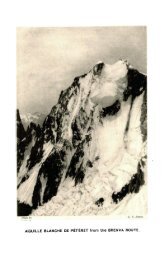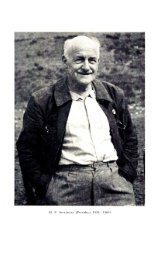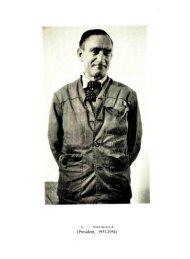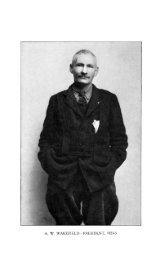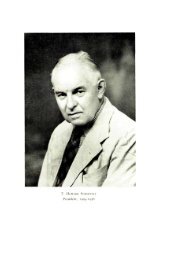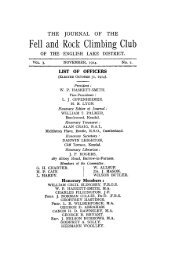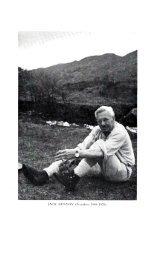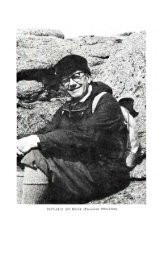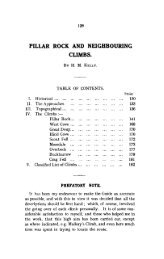Number in series 70; Year of publication 1986 - Fell and Rock ...
Number in series 70; Year of publication 1986 - Fell and Rock ...
Number in series 70; Year of publication 1986 - Fell and Rock ...
You also want an ePaper? Increase the reach of your titles
YUMPU automatically turns print PDFs into web optimized ePapers that Google loves.
28 A SHORT HISTORY OF LAKELAND CLIMBING - PART Iattempt on this out <strong>of</strong> Mickledore Chimney had been started but ab<strong>and</strong>oned byKelly some years earlier) <strong>and</strong> made the first ascent by the Mickledore Grooves.The other great climb <strong>of</strong> this year was due to the <strong>in</strong>spiration <strong>of</strong> an equallybrilliant young cragsman, Maurice L<strong>in</strong>nell, whose untimely loss <strong>in</strong> 1934 was adisaster to British climb<strong>in</strong>g only to be compared with the death <strong>of</strong> Herford.L<strong>in</strong>nell had climbed a great deal with Kirkus <strong>and</strong> was himself responsible forone <strong>of</strong> the hardest <strong>of</strong> all the hard Clogwyn du'r Arddu climbs. And now <strong>in</strong>conjunction with A.B. Hargreaves <strong>and</strong> A.W. Bridge (who must be reckonedjo<strong>in</strong>t leader) he made the first Girdle Traverse <strong>of</strong> Pillar <strong>Rock</strong>. At this po<strong>in</strong>t wemay summarise the <strong>in</strong>terven<strong>in</strong>g <strong>and</strong> subsequent history <strong>of</strong> the famous Stone,which was last mentioned <strong>in</strong> connection with the great campaign <strong>of</strong> 1919. In1920 <strong>and</strong> 1923 Kelly made further climbs on the West Wall <strong>of</strong> Low Man, <strong>and</strong> <strong>in</strong>1928, <strong>in</strong> company with H.G. Knight, yet another route, this time on the westwall <strong>of</strong> Walker's Gully. The Girdle Traverse opened the eyes <strong>of</strong> climbers to thepossibilities <strong>of</strong> the last <strong>in</strong>violate section <strong>of</strong> Pillar—the formidable stretchbetween the North <strong>and</strong> North-West climbs, <strong>and</strong> A.T. Hargreaves made two newroutes here <strong>in</strong> 1932 <strong>and</strong> 1933, the Nor'-Nor'-West Climb <strong>and</strong> Hadrian's Wall,which are among the hardest <strong>of</strong> the Pillar climbs.Meanwhile, L<strong>in</strong>nell had turned his attention to the East Buttress <strong>of</strong> Scafell<strong>and</strong> <strong>in</strong> the summers <strong>of</strong> 1932 <strong>and</strong> 1933 (the last summer, alas! <strong>in</strong> which he was toclimb) launched a <strong>series</strong> <strong>of</strong> great attacks with the result that this supremelyformidable face, which three years before had been unclimbed, now possessedseveral magnificent routes. Two <strong>of</strong> these, it must be mentioned, were led byA.W. Bridge <strong>and</strong> A.T. Hargreaves respectively, but L<strong>in</strong>nell was <strong>in</strong> at both <strong>and</strong>was himself responsible for the rema<strong>in</strong>der.SummaryWith this <strong>series</strong> <strong>of</strong> splendid leads our tale <strong>of</strong> first ascents may fitly close. If ithas been too much a tale <strong>of</strong> first ascents, we can only plead that these, likespecific advances or battles <strong>in</strong> military history are the obvious, convenient pegson which to hang the ske<strong>in</strong>. But we have tried to <strong>in</strong>dicate throughout the broadbackground <strong>of</strong> general development that lies beh<strong>in</strong>d these glitter<strong>in</strong>g fires <strong>of</strong><strong>in</strong>dividual performance; <strong>and</strong> the present is a convenient stage at which to reviewa few <strong>of</strong> the more general aspects which have received too scant attention.We have seen how British climb<strong>in</strong>g, orig<strong>in</strong>ally—like Alp<strong>in</strong>ism—a pursuit <strong>of</strong>summits, <strong>and</strong> for long regarded even on its technical side as a humble h<strong>and</strong>maid<strong>of</strong> Alp<strong>in</strong>ism, gradually established itself as an <strong>in</strong>dependent sport, <strong>in</strong> which theroute is followed for its own sake. We have seen, too, how the early climbers,ever prone to seek the deeper recesses <strong>of</strong> the crags for their big routes, weregradually driven <strong>in</strong>to the narrower fissures, <strong>and</strong> f<strong>in</strong>ally forced out on to theridges <strong>and</strong> open faces.198



